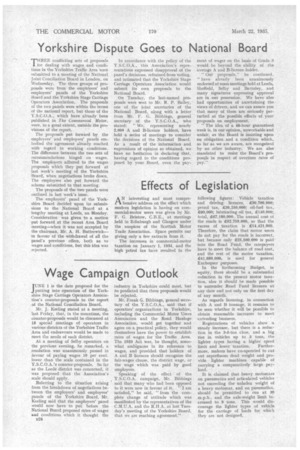Effects of Legislation
Page 38

If you've noticed an error in this article please click here to report it so we can fix it.
N interesting and most compre hensive address on the effect which modern legislation is having on commercial-motor users was given by Mr. F. G. Bristow, C.B.E., at meetings held in Edinburgh and Glasgow under the auspices of the Scottish Motor Trade Association. Space permits our giving only a few extracts from it.
The increases in commercial-motor taxation on January 1, 1934, and the high petrol tax have resulted in the
following figures: Vehicle taxation and driving licences, £30,700,000; petrol tax, £36,250,000; oil-fuel tax, 290,000; lubricating oil tax, 2140,000;.. total, £67,180,000. The annual cost of the roads is £52,759,000, so that the excess of taxation is 244,421,000. Therefore, the claim that motor users do not pay for the roads is incorrect, but because only 225,500,000 is paid into the Road Fund, the ratepayers have to meet the balance of road -cost, and the rest of the motor taxation, 241,680,000, is used for general Exchequer purposes.
In the forthcoming Budget, in equity, there should be a substantial redaction in the present motor taxation, also it should be made possible to surrender Road Fund licences at any date and not only on the first day of any month.
As regards licensing, in connection with A and B tonnage, it remains to be seen whether it will be possible to obtain reasonable increases to meet extending business.
Registrations of vehicles show, steady increase, but there is a reduction in the 3-5-ton class, and a big rise in vehicles up to 3 tons, the lighter types having a higher speed
limit and lower taxation. Furthermore, makers have co-operated to cut out superfluous dead weight and provide lighter machines capable of carrying a comparatively large payload.
It is claimed that heavy motorcars on pneumatics and articulated vehicles not exceeding the unladen weight of a heavy motorcar, and on pneumatics, should be permitted to run at 30 m.p.h., and the axle-weight limit increased to 9 tons. This would discourage the lighter types of vehicle for the carriage of loads for which they are not designed.




























































































